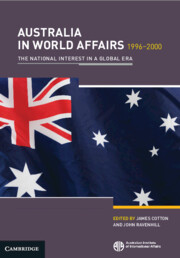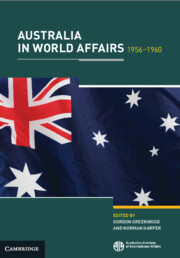716 results
37 - Queer Beginnings at the End of the Frontier
- from Space and the Regional Imaginary of Queer Literature
-
-
- Book:
- The Cambridge History of Queer American Literature
- Published online:
- 17 May 2024
- Print publication:
- 06 June 2024, pp 672-684
-
- Chapter
- Export citation
Perceived Political Polarization and its Differential Impact on Political Participation: Evidence from Japan (2005–2019)
-
- Journal:
- Journal of East Asian Studies , First View
- Published online by Cambridge University Press:
- 30 May 2024, pp. 1-20
-
- Article
- Export citation
6 - Sex in Heian-kyō (Kyoto) in the Tenth through Twelfth Centuries ce
-
-
- Book:
- The Cambridge World History of Sexualities
- Published online:
- 26 April 2024
- Print publication:
- 16 May 2024, pp 108-131
-
- Chapter
- Export citation
9 - Australia and Japan
-
-
- Book:
- Australia in World Affairs 1991–1995
- Published online:
- 04 May 2024, pp 97-107
-
- Chapter
- Export citation
6 - Australia and Japan: Mobilising the Bilateral Relationship
-
-
- Book:
- Australia in World Affairs 2006–2010
- Published online:
- 04 May 2024, pp 82-95
-
- Chapter
- Export citation
4 - Australia’s Relations with South Asia
- from Part II - Relationships
-
-
- Book:
- Australia in World Affairs 1996–2000
- Published online:
- 04 May 2024, pp 39-51
-
- Chapter
- Export citation

Australia in World Affairs 1996–2000
- The National Interest in a Global Era
-
- Published online:
- 04 May 2024
4 - Australia and Japan: Challenges and Opportunities
- from Part 2 - Relationships
-
-
- Book:
- Australia in World Affairs 2001–2005
- Published online:
- 04 May 2024, pp 61-75
-
- Chapter
- Export citation
5 - Australia and Japan1
- from Part II - Relationships
-
-
- Book:
- Australia in World Affairs 1996–2000
- Published online:
- 04 May 2024, pp 52-64
-
- Chapter
- Export citation
Japan’s Forgotten Korean Forced Laborers: The Search for Hidden Wartime Graves in Hokkaido – Corrigendum
-
- Journal:
- International Labor and Working-Class History , First View
- Published online by Cambridge University Press:
- 11 April 2024, p. 1
-
- Article
- Export citation
Faunal community of a new hot vent field on the Amami Rift
-
- Journal:
- Journal of the Marine Biological Association of the United Kingdom / Volume 104 / 2024
- Published online by Cambridge University Press:
- 05 April 2024, e39
-
- Article
- Export citation
Japan’s Forgotten Korean Forced Laborers: The Search for Hidden Wartime Graves in Hokkaido
-
- Journal:
- International Labor and Working-Class History , First View
- Published online by Cambridge University Press:
- 02 April 2024, pp. 1-20
-
- Article
-
- You have access
- Open access
- HTML
- Export citation
Mobilising human resources to build a national communications network: the case of Japan before the Pacific War
-
- Journal:
- Journal of the Royal Asiatic Society , First View
- Published online by Cambridge University Press:
- 02 April 2024, pp. 1-18
-
- Article
- Export citation
Smectite in Marine Quick-Clays of Japan
-
- Journal:
- Clays and Clay Minerals / Volume 30 / Issue 4 / August 1982
- Published online by Cambridge University Press:
- 02 April 2024, pp. 275-280
-
- Article
- Export citation
Nutritional deficiency and ecological stress in the Middle to Final western Jōmon
-
- Article
-
- You have access
- Open access
- HTML
- Export citation
12 - Australia and East Asia: Japan
- from The Regions
-
-
- Book:
- Australia in World Affairs 1976–1980
- Published online:
- 29 March 2024, pp 189-206
-
- Chapter
- Export citation
V - Australian Policy Towards Japan Since 1945
-
- Book:
- Australia in World Affairs 1956–1960
- Published online:
- 29 March 2024, pp 243-271
-
- Chapter
- Export citation

Australia in World Affairs 1956–1960
-
- Published online:
- 29 March 2024
13 - Australia’s relations with Japan and the Korean Peninsula
- from Part 2 - Australia and the Regions
-
-
- Book:
- Australia in World Affairs 1981–1990
- Published online:
- 29 March 2024, pp 246-276
-
- Chapter
- Export citation
9 - Japan
-
-
- Book:
- Australia in World Affairs 1971–1975
- Published online:
- 29 March 2024, pp 231-270
-
- Chapter
- Export citation



